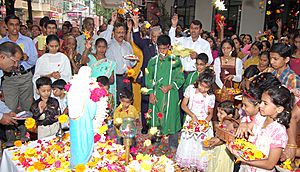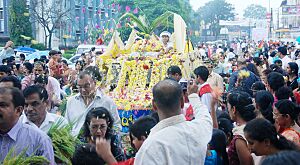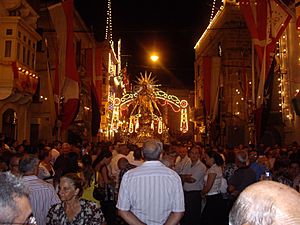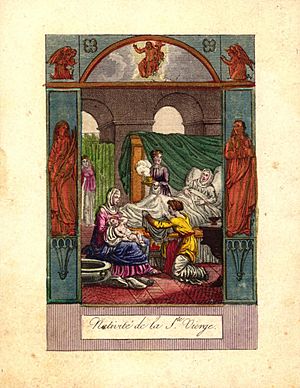Nativity of Mary facts for kids
Quick facts for kids The Nativity of the Blessed Virgin Mary |
|
|---|---|
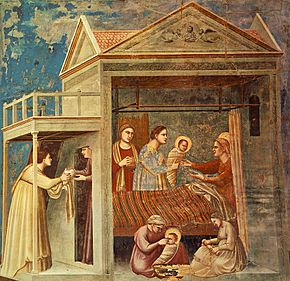
|
|
| Sinless Immaculate Without Original Sin |
|
| Venerated in | |
| Feast |
|
| Attributes | Birth of Mary, by her mother Saint Anne |
| Patronage |
|
The Nativity of the Blessed Virgin Mary is a special Christian holiday. It celebrates the birth of Mary, who became the mother of Jesus. This day is also called the Nativity of Mary, Marymas, or the Birth of the Virgin Mary.
The Bible does not mention Mary's birth. The oldest story about her birth comes from a text called the Gospel of James. This text was written in the late 100s AD. It tells us that Mary's parents were Saint Anne and Saint Joachim.
Usually, the Church remembers saints on the day they died. But for Mary and John the Baptist, their birthdays are celebrated. This is because they both had very important roles in the story of salvation. It is also believed that they were holy from the moment they were born. Mary is believed to have been born without original sin. John the Baptist was made holy in his mother's womb.
People around the world show their love for Mary's innocence. They celebrate this day with many prayers and hymns. One example is the Novena in Honor of the Nativity of the Blessed Virgin Mary.
Contents
The Story of Mary's Birth
The Gospel of James tells us more about Mary's family. It says her father, Joachim, was a rich man. He was part of one of the Twelve Tribes of Israel. He and his wife, Anne, were very sad because they could not have children.
Some old stories say Mary was born in Sepphoris. A church from the 400s AD was found there. Other stories say she was born in Nazareth or near the Sheep Gate in Jerusalem. It is possible that a rich man like Joachim had homes in different places. However, we cannot be completely sure about these details.
How the Celebration Started

The first record of Marymas is from a hymn written in the 500s AD. The celebration might have started in Syria or Palestine. This was after the Council of Ephesus, when people began to honor Mary even more.
The first church celebration was linked to a church in Jerusalem. This church was built in the 400s AD. It was believed to be the home of Mary's parents. In the 600s AD, people in the Byzantine Empire celebrated Mary's birth. The Latin Church took longer to adopt this holiday. This was because the story of Mary's birth came from texts not included in the Bible. Eastern monks brought the celebration to Rome around the end of the 600s AD.
Old Stories and Legends
The Diocese of Angers in France has a story about this feast day. They say St. Maurilius started it in Angers around 430 AD. On the night of September 8, a man heard angels singing in heaven. When he asked why, they said they were celebrating Mary's birth. However, this story does not have strong historical proof.
When is the Feast Day?
Marymas is usually celebrated on September 8th. This is nine months after the celebration of the Immaculate Conception on December 8th. This date is used by many Christian groups. These include the Catholic Church, most Anglican Churches, and some Orthodox Churches.
However, the Coptic and Ethiopian Orthodox Churches celebrate it on May 9th. Churches that follow the old Julian Calendar, like the Russian Orthodox Church, celebrate on September 8th of their calendar. This date is September 21st on the Gregorian Calendar we use today.
Before changes made by Pope Pius XII, the celebration lasted for eight days. This "Octave" was started by Pope Innocent IV in 1243.
Customs Around the World
Saint Andrew of Crete said that everyone is joyful on this day. He said Mary's birth is a happy start to humanity's salvation.
France
In France, Marymas is called "Our Lady of the Grape Harvest." Winegrowers bring their best grapes to church to be blessed. Some bunches are then tied to a statue of Mary. A special meal with the new grapes is part of the celebration.
India
In Kerala, India, Mary's Nativity is called Nalpiravi. It is a big celebration for Saint Thomas Christians. It is always celebrated for eight days. From September 1st to September 8th, people avoid meat and alcohol. During this time, families prepare vegetarian food. Churches hold charity events and special prayers for Mary. Praying the Kontha (the Holy Rosary) in groups is also important. On Marymas day, a sweet pudding called Pachoru is made. It uses milk, rice, and jaggery. It is given to people at churches. At home, families prepare a festive meal with meat and fish.
In Goa, India, Mary's Nativity is called the Monti Fest. It is a big family celebration. It is a time to thank God for the new crops. People have a festive lunch with blessed grains from the harvest. Showering flowers on a statue of Mary is a common custom. In Mangalore, it is also called "Monthi Fest." On this day, Christians eat pulses and vegetables. A priest blesses a branch of grain, which is added to food. Before the feast, there are nine days of novena prayers. People also offer flowers to a statue of baby Mary.
In Mumbai, India, Mary's Nativity is celebrated with a week-long event called Bandra Fair. It starts on September 8th or the Sunday after. It takes place in the Bandra area around Mount Mary Church.
Malta
In Malta, the feast of the Nativity of the Virgin Mary is called Il-Bambina. It is also known as Victory Day (Jum Il-Vittorja). This is because the day matches three big victories in Maltese history. These include a turning point in the Great Siege of Malta in 1565. Also, the surrender of French troops in 1800, and the end of the Siege of Malta in 1942.
The Bambina is celebrated in four towns: Naxxar, Senglea, and Mellieħa in Malta, and Xagħra in Gozo. Mary is also honored as Our Lady of Victories. Churches are decorated with red cloth. The celebrations include brass band concerts, fireworks, and church services. A procession with a statue of the Bambina is also held. At Fort St Angelo, Mass is celebrated in two chapels.
Mary in Art and Devotion
The birth of Mary is often shown in art. It is part of stories about the Life of the Virgin. In medieval art, Mary as a baby is often shown with Saint Anne. Later art often shows her birth in a rich home.
In 1730, people in Lovere, Italy, started to show devotion to Mary as a baby. A wax statue of the Santissima Maria Bambina was honored there. It was later moved to Milan. In Southern France, a custom called Globe de Marièe developed. A baby Mary statue is placed on a cushion. This represents children and fertility for new brides.
A similar devotion to Mary as a toddler grew in places like Mexico, Guatemala, and the Philippines. Here, La Niña María is shown as a young girl.
In 1800s Mexico, a nun named Sister Magdalena started a devotion to the infant Virgin. She used the head of a cherub angel from a broken monstrance to create a holy image. Later, a visionary named Rosario Arrevillaga started a religious group for this devotion. It was called the Order of the Slaves of the Immaculate Child.
Pope Benedict XV recognized the image of Mary in Senglea, Malta. It is called "Our Lady of Victories." Archbishop Mauro Caruana crowned it on September 4, 1921. This image was once on a Catholic ship. The ship was wrecked in 1618 near the Dalmatian islands. The image was saved and brought to Senglea. The town celebrates its feast on September 8th. The statue is also known as Maria Bambina.

In the Philippines, people also love the toddler Virgin. They dress her in soft colors and crown her with flowers. This shows her innocence. Unlike adult saints, she does not wear a traditional crown. Candies and cakes are often offered to her. She is called La Dulce María, or the Sweet Mary. On December 27, 2018, the House of Representatives of the Philippines approved a bill. It made September 8th a working holiday for Mary's birthday. On August 13, 2019, President Rodrigo Duterte signed a law. It made September 8th a special working holiday across the country.
Some places celebrate Mary's birth with their own local images:
- Cuba — Our Lady of Charity
- Philippines — Virgen de los Remedios de Pampanga
- Philippines - Nuestra Señora de la Natividad de Pangil
- India — Our Lady of Good Health
- Malta — Our Lady of Victories
On the Maltese Islands, Marymas is also called the Feast of Our Lady of Victories. This is because it happens on the same day as several important events in Maltese history. September 8th is a national holiday there. It is known by many names, including Victory Day, il-Vitorja, and il-Bambina.
Places of Worship
Roman Catholic Churches
The Nativity of the Blessed Virgin Mary Cathedral is in Biloxi, Mississippi. There is also a Cathedral of the Nativity of the Blessed Virgin Mary in Juneau, Alaska. The Nativity of Mary, Blessed Virgin Catholic Church in High Hill, Texas is a historic church built in 1906. The Nativity of the Blessed Virgin Mary Parish in Lorain, Ohio was started in 1898 for the Polish-American community. Nativity of Mary Catholic Church and School is in Bloomington, Minnesota. It is part of the Archdiocese of Saint Paul-Minneapolis.
Orthodox Churches
The Nativity of the Virgin Mary Orthodox Church in Madison, Illinois is part of the Orthodox Church in America Diocese of the Midwest. The Nativity of the Theotokos Monastery in Saxonburg, Pennsylvania is the first Greek Orthodox women's monastery in America. It was founded in 1989.
Mary's Birth in Islamic Texts
Mary's birth is also told in the third chapter of the Qur'an. It mentions her father, Imran, and her mother, Hannah. Hannah prayed to God for a child. She promised that if her prayer was answered, her child would serve God. She also prayed for her child to be protected from Satan. Islamic tradition says that only Mary and Jesus were born without the "touch of Satan."
See also
 In Spanish: Natividad de la Virgen para niños
In Spanish: Natividad de la Virgen para niños


